Your Go to Market strategy
Stand out & scale
Our GTM and brand positioning services set us apart from the competition. It is how we’ll set you apart too.


A GTM and brand positioning strategy helps to identify your viable audience, provides a clear roadmap and gives your management team and investors confidence that you are in control.
Our proven GTM process will help you to understand your prospects and their buying journey deeply, craft your market and brand position, convey your messaging and the value you deliver, as well as identifying the right channels to market.
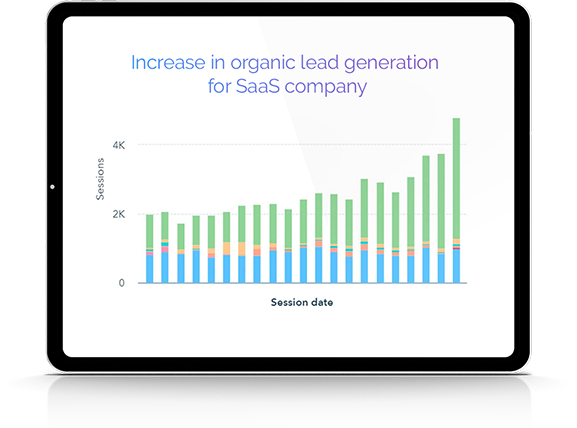
Strategy is what makes us great.
Our team have created strategies that helped to elevate companies like GoCardless from fledgling startup to tech-giant unicorn.
We’ve seen it all before, and we’ll work together to build the bedrock you need to make your business a success.
Identify your buyer personas. Who do you really want to attract?
Speak your prospects’ language and address their pain points
Lead with your differentiators not your features. Tell your prospects why you’re different and why they should care
Showcase the true value you deliver
Create your messaging platform for marketing and sales alignment
Identify the right channels to market for customer acquisition
These are the most common reasons that businesses fail – all of which can be addressed through a clear GTM strategy.
No defined audience. Going after allcomers
Not understanding audience pain points
Saying the same thing as competitors leading to a decreasing price focus
Talking about features of your platform rather than value, benefits and outcomes
No clear market or brand position
No real differentiators of note
Being in every channel whether it's relevant or not
Unrealistic expectations regarding results and ROI
Customer acquisition is stalling. Churn is high
Competitors attacking your market position
Messaging that once worked well no longer resonates
Unable to break into new markets
Unwieldy processes and structures that are not scalable – no automation
No understanding of what’s working and what’s not across the channels
Poor alignment across marketing and sales
Decreasing ROI with no clear plan

Becks has a proven track record of defining positioning and marketing strategies and delivering the foundations required for tech companies to achieve their growth and lead generation ambitions, often within challenging parameters. Becks will steer you through the initial stages of engagement with her energetic yet #noflluff marketing approach to ensure you have the right foundations in place. Becks will remain on-hand throughout your engagement.
In the last few months since working with IE, we have seen our net new business grow phenomenally. We’ve generated more than £100K of booked and committed revenue purely from the PPC and SEO efforts of Incisive Edge.
To scale you need to be positioned correctly. To win the hearts and minds of your target audience. So how do you make that step-change?
Our Go To Market Plan and Brand Positioning Strategy Workshop process gets to the heart of your challenges quickly and creates the marketing foundations and execution plan on which your channel strategies are built.
If you really want to take control of your marketing to drive revenue growth and scale, your success starts with your GTM.
Book an informal chat with Julia to see how we can work together to create your GTM strategy and position your tech business for growth.
In our session together, we’ll quickly understand your business and current lead channels and recommend strategies and execution tactics that will help you expand faster.
Schedule a 30-minute call with tech marketing expert, Julia Payne.
What is a Go to Market strategy or GTM strategy? In simple terms, a Go to Market (GTM) plan sets out the step-by-step procedures that enable a business organisation to bring a product or service to market. Business analytics firm Gartner Inc. goes further, describing a Go to Market strategy as a plan that details how an organisation can engage with consumers to convince them to buy their product or service, and to gain a competitive advantage.
On the surface, a Go to Market strategy is similar to a business plan, but has a somewhat narrower focus. A GTM strategy will typically include tactics related to pricing, sales and marketing channels, the buyer’s journey, new product or service launches, the branding or rebranding of products, or the introduction of a product or service to a new market.
Go to Market strategies generally seek to identify potential customers, establish product market fit, develop a marketing plan, and set up a sales strategy for a particular product or service.
Although every product or service may be different, a Go to Market strategy should in all cases establish buyer personas for a target market, identify pain points or problems that these potential customers experience, and position the product or service as a must-have solution to these issues.
Each type of business model will have a particular marketing strategy, sales strategy, content marketing strategy and customer management strategy that contribute to an effective service or product launch, and enable the successful company to generate demand and achieve competitive advantage. This applies whether your organisation is a startup, scaleup, or an established enterprise or service provider.
Though individual aspects of each GTM strategy will vary, there are four Go to Market models that cover most applications. All of them involve some degree of market research, strategic planning, innovation, and testing. The 4 types of marketing strategies are:
The objective of inbound marketing is to create non-invasive brand recognition, and to nurture potential customers towards purchase throughout the buyer’s journey. Outreach mechanisms include content marketing (blogs, infographics, webinars, etc.), the staging of in-person or virtual events, engagement on social media, and search engine optimisation (SEO).
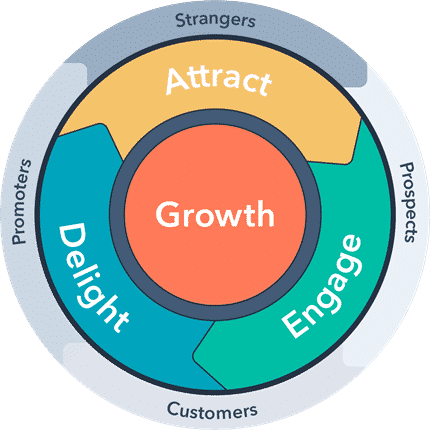
(Image source: HubSpot)
(Image source: Highspot.com)
The sales enablement business model focuses on empowering the sales team through product or service-specific training, content provision, and the deployment of specialist tools or solutions like customer relationship management (CRM) platforms. This type of GTM model applies to sales personnel at all stages of the sales cycle.
The account-based marketing Go to Market model is tailored for the Business to Business or B2B sector. It involves a high degree of collaboration between the sales team and the marketing team, who combine forces to identify high value accounts and engage with them to generate demand and close deals. This engagement may take place through content marketing, technology deployment or exchange, marketing campaigns staged across multiple channels, and other mechanisms.
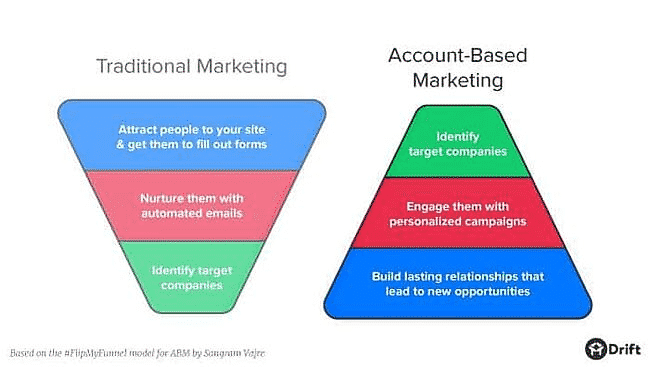
(Image source: Drift.com)
(Image source: Business2Community.com)
A largely outbound value proposition, demand generation puts its marketing efforts into more traditional or “old school” techniques like cold calling, speculative email marketing, sponsored webinars, paid advertising, or list buying. Since the customer acquisition cost using demand generation alone can be quite high, many organisations use it in combination with other Go to Market strategies.

I was referred to Incisive Edge and what a great referral. Their data-led approach and value-led content has given us the platform, position
and strategy that is both realistic and achievable. And they have achieved it. Their clear and practical strategy, followed through with fantastic
execution has been transformational.
Ed Conklin
ceo

Any project that aims to attract new customers needs a Go to Market strategy. Some scenarios that this would apply to include:
In all cases, the GTM strategy should help the organisation clarify why it is staging the service or product launch, its target market, and the steps needed to achieve competitive advantage by engaging with existing customers, potential customers, and/or decision makers who can authorise purchasing transactions.
Even companies that consider themselves stable with products or services that enjoy an established track record can benefit from regular Go to Market strategy reviews. These provide an avenue for organisations to identify prevailing trends and prepare for new competition and other market forces.
Though it is possible to succeed without a Go to Market strategy, for that to happen, you would need a once-in-a-generation product or a huge amount of luck. By gathering market intelligence and information on the needs and pain points of the customer base before a product launch or service rollout, brands can use the insights gained from analysing this data to plot the most effective course of action. In this way, a good Go to Market strategy can mitigate risk and maximise return on investment (ROI).
However, a Go to Market strategy is not enough by itself. Other strategies are needed to ensure growth and gain competitive advantage. In fact, Go to Market strategy is one of a set of principles known as the three pillars of growth:
A product strategy should clearly define the customer pain points or real-world problems that the solution aims to overcome, who benefits from this solution, and how those benefits manifest (e.g., as cost savings, time savings, improved performance, or greater security). The product strategy should also compare the capabilities of the product to similar solutions in the marketplace, articulating how it is better, and any areas in which it falls short.
A revenue delivery strategy sets out the organisation of all operational elements needed to support the growth of a product. As such, the revenue delivery strategy has a broad remit, covering several areas including:
A crucial tool for judging the success or otherwise of a product or service offering is the value matrix.
This construct maps the service or product in terms of the business needs that it satisfies, and sets out the criteria for evaluating how successful it is. For stakeholders in the business, the value matrix also provides information explaining why the product or service has been developed, and defines the customer need that is being met by each specific feature of the product or aspect of the service.
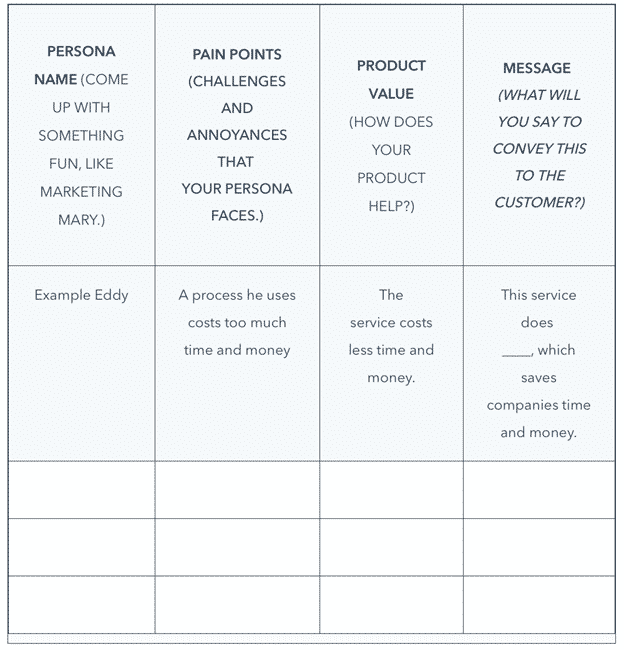
(Image source: hubspot.com)
Here’s an example of a complete value matrix for different users/personas:
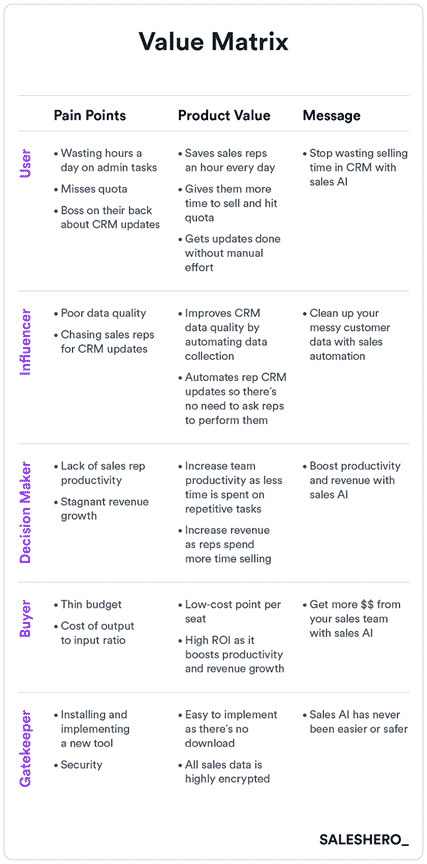
(Image source: hubspot.com)
All three growth pillars must work in combination in order for a product launch or Go to Market project to succeed. For example, a product strategy that leads to the development of a top-notch product will fail if the Go to Market strategy can’t attract any customers. Likewise, a product or service with lots of consumers will fail if sales transactions can’t be processed, or if the organisation fails to sustain its service levels as set out in the revenue delivery strategy.
However, there is no “one size fits all” solution. The way you approach your Go to Market strategy will depend on what will be driving your growth. Broadly speaking, this will likely come down to one of two factors – growth that is product-led, or growth that is sales-led.
Here, the product sits at the heart of growth. In a product-led Go to Market strategy, the product serves not only as the solution to a business problem, but also acts as a silent salesperson by letting customers buy, renew, and upgrade without leaving the product. This self-service sales model eliminates the involvement of a salesperson at the point of purchase, and also during the discovery and research phase of the sales journey. In theory, everything that a potential customer wishes to know – from the features and technical requirements of the solution to its pricing options and contract terms – should be available within the product.
Product-led Go to Market strategies are a speculative volume play. They routinely involve tactics such as “freemium” offers designed to attract users initially, before turning them into paying customers later.
In a product-led Go to Market strategy, the product is the core sales channel, and the distinction between product strategy and Go to Market strategy becomes blurred. Elements such as site architecture, product design, and user experience (UX) define the customer journey and assume greater importance for the Go to Market strategist.
In a sales-led Go to Market strategy, human agents initiate and close sales. Although the product will be a key part of any sales conversation, the sale itself (and any future renewals or upgrades) will occur away from the product or service platform. This approach tends to predominate in situations where the product is so revolutionary, complex, or expensive, that the buying decision involves many stakeholders and many engagements – often taking place over a period of months. The strategy involves a resource-intensive sales process, which obliges the business to focus on achieving fewer sales at higher margins.
Since sales-led Go to Market strategies are directed by people and the product plays less of a role, the link with product marketing is weaker. Instead, in a sales-led growth plan, product marketing and Go to Market strategies will converge at the start to define the benefits of the solution and the target audience. In addition, with the product not acting as the vehicle for processing orders, in a sales-led Go to Market strategy, product and revenue delivery strategies are more detached.
Whether you’re launching a new startup or a new product, a good Go to Market strategy includes certain core elements. This applies irrespective of whether you’re following a product-led or sales-led path to growth.
Here are four of the main components you should consider when creating a Go to Market strategy, with illustration courtesy of HubSpot analyst and startup founder Stefan Groschupf, using a successful company that he started as an example:
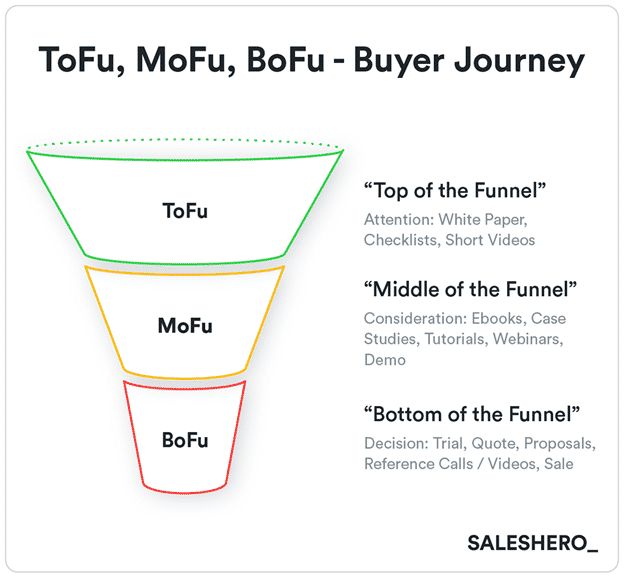
(Image source: HubSpot)
As we saw with the relationship between Go to Market, product and revenue strategies, these components are interdependent. This means that the answer to one question will inform (or invalidate) another.
In fact, every Go to Market strategy will tend to be driven by the history or culture of a business.
Startups whose founders set out to fix a problem that frustrated them will likely begin with the product-market fit and engineer a business model around that. By contrast, an enterprise vendor with the means to innovate quickly may be driven by what their customers are telling them they need. In an alternate scenario, an opportunistic entrepreneur may conclude that every product in a range is overpriced or suffering from poor customer service, and so set out to create a remedy.
Where you begin with your Go to Market strategy is not as important as making sure that you focus on all four elements in parallel. This will ensure that your final Go to Market strategy is holistic, thorough, and consistent.
Why are you launching this product right now – and what do you hope to gain from it?
The first phase of your Go to Market strategy should explain how this product aligns with your overall business plan and strategy. You can craft a short explanation of how it ties into your other offerings, or how you’re approaching a new market. Whatever your line of approach, be specific, concise, and honest.
What problems does your product solve for people – and how have you validated that need?
Demand isn’t always so easy to determine. In fact, an analysis of over 100 startups who recently shut down last year found that 35% didn’t solve a valid customer problem, meaning there was no market need for the solution.
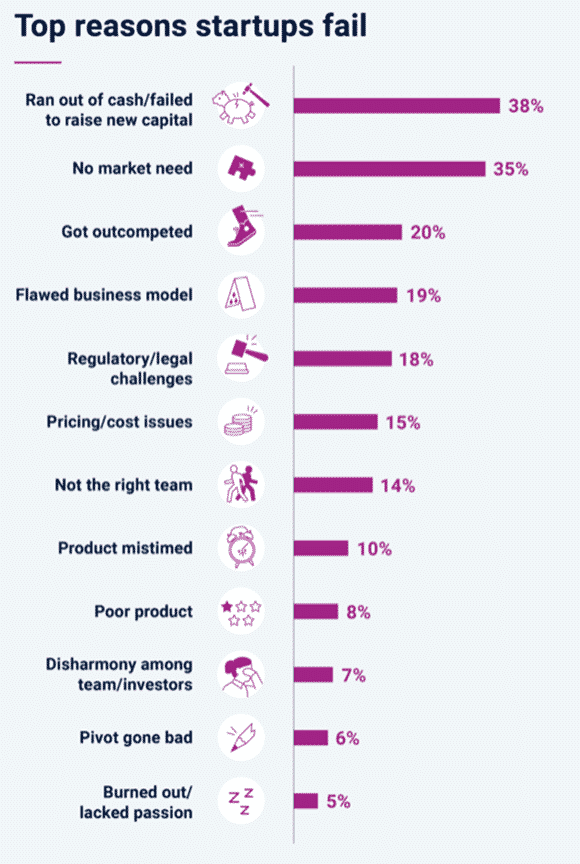
(Image source: cbinsights.com)
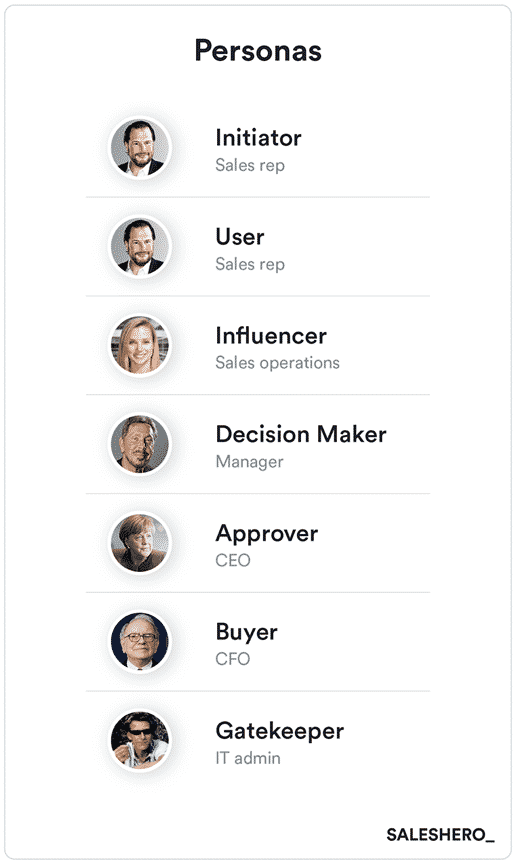
(Image source: HubSpot)
As you put together your Go to Market strategy, dig deep into the “why” that led you to build this product in the first place. How do you know that your users want and need it? Have you tested and validated the idea with real people?
You should also consider your long-term strategic objectives. How will your product change and adapt? What do you want to see happen in six months or a year?
Product purchasing scenarios will usually fit one of two cases. In the first situation, the purchasing party is a non-business customer or a small business. In the second case, the purchasing party is a larger enterprise.
When your target market is non-business consumers, you need to create a realistic buyer persona. This will assist in developing products and creating content to better target potential buyers. A buyer persona is a semi-fictional character based on research, with characteristics of your ideal customer. Typical features of a buyer persona are a unique name, behavioural traits, demographic information, and interests.
To create buyer personas, you can carry out audience research to determine the age, location, interests, spending patterns, and pain points of your ideal buyers, with the help of Google Analytics, your customer database, and social media analytics. You can then identify the problems your target audience is trying to solve and understand what support you can offer.
When creating the buyer persona for larger businesses or enterprises, your course of action will be different. The first step is to analyse who will buy your product and who will make the purchasing decision for your offering. These decision-makers are called “the buying centre”.
Having defined the buyer personas, you now need to clarify their problems and establish whether your product or service will fit their needs. At this stage, you should consider the value proposition of your product, and the pain points afflicting your buyer personas on a daily basis. You should also consider the bigger picture, looking at the endemic problems facing your industry as a whole, and the likely impact of your product on the target market.
Study your competition and define the features of your product that differentiate it from existing solutions. It is essential to learn what your target market likes and dislikes about the available products.
Where does your product fit in the market? How do you want people to view you in relation to other products out there?
In order to establish this, you’ll benefit from consulting with a marketing and content development team that has experience in steering product launches, identifying and analysing existing and emerging markets, and developing Go to Market strategies that position a product or service as a “must have” for a particular niche. That way, you’ll be able to position your offering as, for example, a “luxury AirBnB”, “a more affordable and powerful version of Slack”, or whatever is most appropriate.
Messaging is a set of key points defining how your company communicates about itself and the value you provide to consumers. The core messaging about your company, product, or service will become the basis for various marketing materials, such as slogans, press releases, social media posts, presentations, and digital content.
Start by defining your company’s market strategy and the objectives you wish to achieve through your messaging. The next step is to identify the keywords that should be associated with your company, product, or service. This knowledge will enable you to draft concise and memorable message statements, which you can organise into a framework, including your target audience, brand positioning, and brand promise.
The messaging strategy used by your competitors is a good source of data to assist in developing your own statements. Identify the distinguishing factors that set you apart from the competition. What makes your product unique, and why should your customers choose it over the other offerings?
Remember that while your message should convey the main idea about your product or service to potential buyers, it is crucial to establish an emotional connection with your customers that addresses their needs and desires. So don’t be afraid to use humour and speak to consumers in the natural language they use in everyday life.
How will people use your product? How can you help them imagine a life that’s better because they’re a customer of yours?
An effective way to communicate this is through the presentation of typical scenarios or use cases that involve the employment of your product or service in real-life situations relevant to your target market. This might take the form of case studies involving existing products, or the production of videos and imagery highlighting the use of your product in real-world applications.
An understanding of the buyer’s journey helps in predicting your customer’s behaviour, and the number of stages involved in the purchase process. Consider the customer’s journey both from the perspective of the buyer and of your own company.
The buyer’s journey typically consists of four stages:
While your pricing structure needs to make sense in terms of your business model, pricing is more than just a financial decision. It is also an indication of the value that you’re going to provide to consumers.
Pricing reflects every other aspect of your Go to Market strategy – from your customers themselves, to the market, to how you implement strategies like PR, marketing and sales. As such, it needs to be a purposeful and deliberate choice.
Think about the message you convey with your pricing. Are you a premium product that will need to be aggressively marketed? Or are you trying to undercut the current competition and attract new customers with lower price levels?
What sort of external marketing are you going to use to tell people about your new product?
This is an important consideration regardless of your Go to Market strategy, especially if your product is marketing intensive. If you’re going to avoid direct selling and expect customers to find you through ads and content, then you should pay special attention to this section of your marketing plan.
Here are the broad elements you should cover:
Who are you? What promises do you make as a company – both through the language you use to describe yourself, and the way you present yourself visually? If you already have strong and well-established brand positioning for your company, is this new product consistent with it?
How will you locate people to become customers? There are many different ways to find leads and generate demand for your product (organic, SEO, paid advertising, etc.). How are you going to do it?
What value are you creating for users outside of the product? Content is a powerful way to get in front of potential customers and show them that you’re knowledgeable and trustworthy. Consider what you can teach users and how your content strategy can help support your launch with things like blog posts, videos, eBooks, and whitepapers.
Will the main information about your new product be on your main site or on a micro-site? How will you explain your value proposition in a way that is quick and compelling enough to get people to purchase?
What else can you do to get people interested? Think outside the box. This could mean using paid ads, search engine marketing, hosting or presenting your product at events, and using PR to amplify your launch in other outlets.
How are you going to empower your sales team to help you get a piece of the market?
If your product is more sales-intensive, you’ll want to spend more time outlining how you expect the sales process to work. You’ll want to make sure that each sales rep going out and representing your product has all the resources and knowledge they need to be successful.
Here are a few things you should include here:
Tools and resources: How will your sales team find, engage with, and sell to potential customers? What tools are they going to use to manage relationships and demonstrate the product? Are they familiar with the key marketing channels where your customers are active? Are they in the loop with the latest Instagram trends, LinkedIn scraping/prospecting trends and other techniques?
Client acquisition: What’s the correct approach for finding clients? Inbound sales? Outbound sales? Cold calling? Resellers and partners?
Training support: How will you train the sales team so that they’re knowledgeable enough and confident in selling the product?
Good customer support turns your one-time buyers into customers for life. To develop loyalty and make the buyer feel special, you should create friendly customer service. Here, it’s important to think about what you can offer to your clients to help them use your products – the tools, software, and customer support team. Consider using social media platforms to monitor and respond to queries and complaints.
You should continually review your Go to Market strategy and adapt it if necessary to ensure success. To enable this, your GTM strategy must include meaningful and measurable Key Performance Indicators (KPIs) that track both short-term (even real-time) performance and long-term sustainable growth indicators. The number of KPIs you track will depend, in part, on your ability to gather the necessary data and report on it. Modern data analytics platforms enable businesses to get a more accurate and granular reading of success than ever before. That said, keep things in perspective. Limiting yourself to KPIs that can help drive decision-making is more effective than drowning in numbers – what is known as “analysis paralysis”.
Many Go to Market strategies will visualise progress in terms of a funnel. At the top of this funnel are all the target consumers that have been identified, and at the bottom are those who progress to become paying customers. By dividing the funnel into various sections, you can measure the success of each step of the acquisition journey. This will also enable you to understand what is working, and what elements need refining. If you’re running a subscription model, you’ll need to extend the funnel to measure factors like churn, lifetime revenue, and recurring revenue.
There are limitless KPIs for a Go to Market strategy. Here are some examples:
For product-led growth strategies where the website is the core sales tool, measuring engagement on the site is fundamental:
A Go to Market team assumes responsibility for the success or failure of a product or service launch. Ideally, they should also monitor and optimise the projected revenue and growth of the project.
Product managers are responsible for communicating timing and progress to internal teams, such as sales and support.
Senior product marketing leaders set the Go to Market strategy and coordinate with a cross-functional product team (which typically consists of product, marketing, sales, and support) to implement the launch.

Organisations needing to walk prospects, customers, or employees through technical subject matter often encounter difficulties in explaining screen sharing during presentations. The interactive screen sharing platform Upscope came to market with a solution offering intuitive controls that greatly simplify the process. The company is supporting its Go to Market efforts by maintaining a web knowledge base and blog and offering integrations with other popular business tools.


A number of Go to Market samples and templates are available online. Examples include:
It’s common wisdom now that 90% of startup ventures will fizzle out – often within their first year. A lack of thoughtful planning is one of the most common reasons for startup failure. A robust GTM strategy can provide a hedge against future risks.
To begin, you will need to choose between a number of options: a broad set of buyers or narrow target market, channel sales or direct sales, and two-sided or one-sided markets. Then, consider the four key components of GTM strategy:
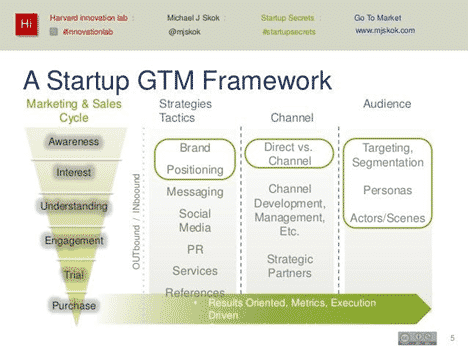
(Image source: Harvard Innovation Lab)
Entrepreneur Michael J Skok has created a startup GTM strategy framework for the Harvard Innovation Lab. In this scheme, a simple marketing and sales cycle describes the stages a potential customer passes on the way to the purchase of the product.
At first, the customer becomes aware of your offering, then their interest awakens, and they develop an understanding of how the product can serve their needs. Stages that follow are the engagement of the potential buyer, purchase of the trial version, and finally, the purchase of the complete product.
It can be difficult to measure the extent and success of audience engagement, and the potential for turning interested potential customers into actual buyers. To help you estimate the results, you’ll need to pay attention to metrics like the Net Promoter Score or NPS.
For startups, the building of a brand should focus less on the product or service, and instead concentrate on creating the brand identity through the founders of the venture, their development and support teams, the ideas and principles they stand for, and the company’s culture. From the beginning, consistency is key to ensure brand integrity.
When launching a startup, answer the following questions:
Note that for startup ventures, achieving product-market fit is a key element for success. Having achieved this, acquiring customers becomes that much easier. As such, another key question to ask in the early stages is – what can we do to get 1,000 customers who will be very disappointed if our product no longer exists?
For well-established businesses, the Go to Market strategy incorporates seven directions of growth:
In the digital economy, many established enterprises operate as service providers. This includes the “as a Service” sector of cloud computing and Information Technology. For organisations in this arena, entrepreneurs are advised to limit the number of markets that they target at any given time, and to keep their number of marketing channels down to reasonable limits.
Another mistake to avoid is reaching out to enterprises with a long and complex sales cycle. For “as a Service” operators, the Go to Market strategy generally targets people who are decision makers within the companies or institutions where they operate. This provides marketers with the opportunity to offer free trials of software and platforms, and eliminates the need to communicate with a sales rep before purchases can be made. This template from DevSquad provides a Go to Market strategy for Software as a Service (SaaS) providers:
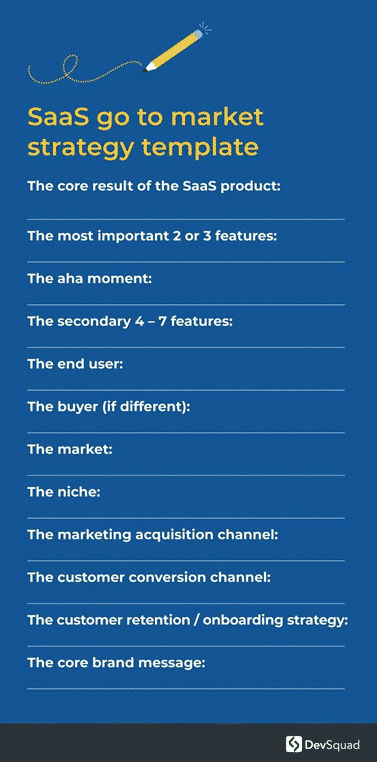
(Image source: DevSquad)
Book an informal chat with one of our growth experts to see how we can work together to create your GTM strategy and position your tech business for growth.
In our session together, we’ll quickly understand your business and current lead channels and recommend strategies and execution tactics that will help you expand faster.
Schedule a 30-minute call with tech marketing expert, Julia Payne.